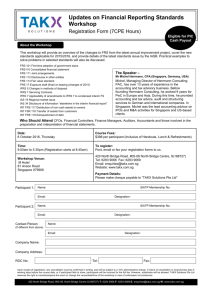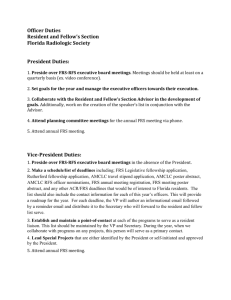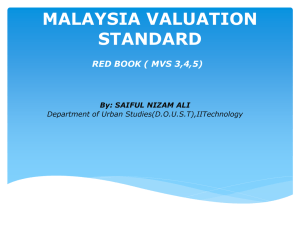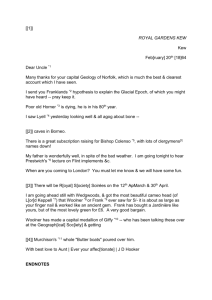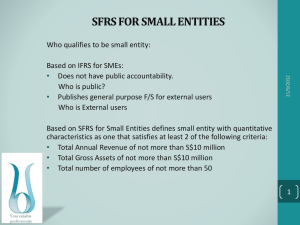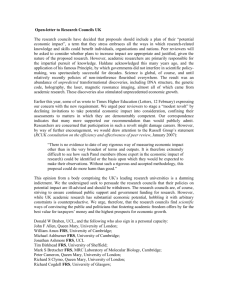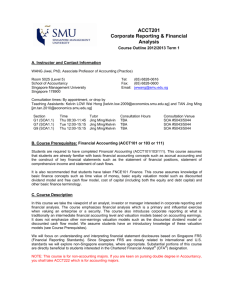Facilities Reservation System (UCR) - University of California | Office
advertisement
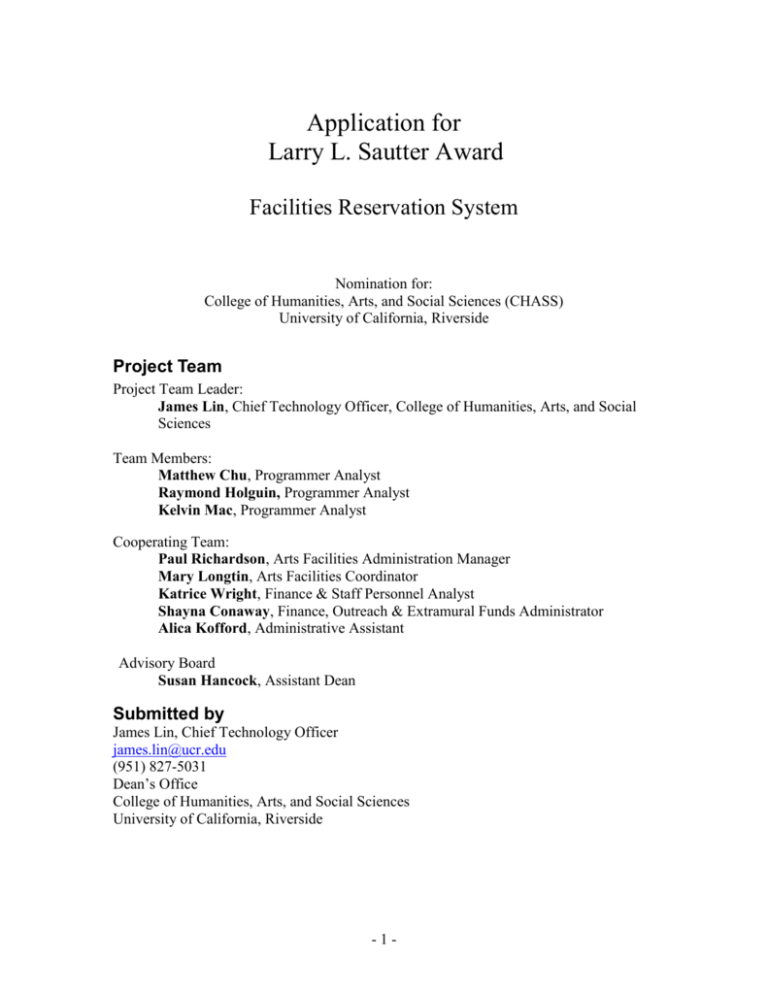
Application for Larry L. Sautter Award Facilities Reservation System Nomination for: College of Humanities, Arts, and Social Sciences (CHASS) University of California, Riverside Project Team Project Team Leader: James Lin, Chief Technology Officer, College of Humanities, Arts, and Social Sciences Team Members: Matthew Chu, Programmer Analyst Raymond Holguin, Programmer Analyst Kelvin Mac, Programmer Analyst Cooperating Team: Paul Richardson, Arts Facilities Administration Manager Mary Longtin, Arts Facilities Coordinator Katrice Wright, Finance & Staff Personnel Analyst Shayna Conaway, Finance, Outreach & Extramural Funds Administrator Alica Kofford, Administrative Assistant Advisory Board Susan Hancock, Assistant Dean Submitted by James Lin, Chief Technology Officer james.lin@ucr.edu (951) 827-5031 Dean’s Office College of Humanities, Arts, and Social Sciences University of California, Riverside -1- Summary The Facilities Reservation System (FRS) is a fully integrated solution for the management of conference/meeting rooms, labs, equipment, and arts facilities. FRS is an online tool designed to streamline the facility reservation processes for both facility users and managers. The system is capable of managing a range of requests, from a single room to an enterprise-wide multiple buildings. With an intuitive and easy-to-use interface, both facility managers and users have been benefited from the time that FRS has saved. Facility managers can manage their facilities and related supports such as equipment availability for each facility, costs, and any other details. From the facility users' perspective, requesting a room is as easy as selecting the facility he or she wants, searching for an available time slot, and completing the online reservation form. FRS’ reservation is similar to the process of reserving a hotel or an airplane flight. While the ultimate decision on who gets the room is the administrator's responsibility, this system eliminates all the paper work and cumbersome bookkeeping that goes with managing facility reservations. All communications between facility managers and users are via email and are kept as records for tracing purposes. It is also designed to help maximize utilization of their facilities and other resources. The FRS can be customized and can be easily integrated with existing enterprise systems. Base on “Power of 10” philosophy, FRS is a free service to the UC community and has been adopted and used by departments from the nine UC campuses: UCR, UCB, UCLA, UCSB, UCD, UCSC, UCI, UCSD, and UCM for managing their facilities. Objective of FRS The main objective of FRS is to reduce staff workload and save money needed to manage academic facilities’ scheduling and billing through re-engineering manual and cumbersome process to a Web 2.0 base technology for the facility users and managers. FRS also aims to help organizations maximize utilization of their facilities and other resources. Description In Fall 2004, staff from the College of Humanities, Arts, and Social Sciences (CHASS) contacted James Lin, Chief Technology Officer of CHASS, for resolving the constant interruption and cumbersome facilities scheduling for conference rooms and arts facilities. A list of commercial software was evaluated and concluded that commercial facility management products typically focus on event-driven business operations and trying to match available facilities to maximize the usage utilizations and profits. They are complex and expensive requiring IT staff for installation, configuration and user supports. With restriction in funding, the solution shall concentrate in providing services to departments that have small number of facilities and have no concern in matching events. For example, academic departments of a university typically have 1 to 3 meeting/conference/seminar rooms that are for their faculty and students’ academic activities. These rooms are managed by administrative staff. Our analysis identified that the majority of those academic departments’ meeting rooms were still managed by administrative staff using paper or other electronic calendars (e.g. Outlook, Oracle -2- Calendar etc). The facility users came to or called the administrative staff to reserve the facility, a people-intensive operation. Academic departments typically did not have IT capacity and budget to afford expensive and complex commercial products. The users were faculty, staff and students of academic department who would need to use department’s facilities frequently and/or repeatedly which caused constant demanding pressure and interruption to department staff’s regular work. The conclusion of the evaluation was to develop the FRS in house to fulfill various unique requirements from the users. From the beginning of the FRS project, the concept of supporting the UC “Power of 10” philosophy was one of the development principles. Object-Oriented and modular design methods, plus Java 2 platform were applied to achieve the portability, reusability, and scalability. Most system parameters are configurable. Open sources Apache Tomcat application server and MySQL database engine were used to make the system portable and an open-system compliance, as well as cost-effective. With innovative software architecture, FRS runs within an Apache Tomcat Servlet container using Java technology in combination with the Spring framework and Hibernate for application control and database transaction management. The facility managers and users can easily access all the information on the server through a webbased interface. Major Features Eliminate Scheduling Conflicts FRS does not allow double-bookings and provides automatic conflict resolution. Quickly displays facility use and availability with colored scheme and graphic views in daily and weekly formats. Finds available time slots with a powerful search tool and filter. Intuitive and Easy to Use The intuitive and E-Commerce style web interface eliminates any need to train users. Users simply click and type on the graphical calendar to reserve facility. Features simple navigation tools on the graphical calendar to select facility, dates and time-slots. On-line calendars display instant space availability. Eliminate Hassles and Save Time Users can create any kind of recurring schedule in seconds. Eliminates phone calls and paper methods by using FRS for online requests and/or self-service reservations. Reduces the time required to schedule reservations and manage the facilities, enabling facility managers to focus on customer service. Its powerful tools efficiently manage all kinds of reservation requests. -3- Improve Communications Facility managers and relevant parties will receive automated change notifications, a confirmation number and a reservation status via e-mail. Provides real-time access to the latest information. A detailed reservation record log tracks every change made to the reservations. Supports multiple facility managers. Provides various reminder mechanisms for the facility managers. Flexible, Adaptable, and Customizable Configures the system to model facility owner’s business practices (multiple rate policies, multiple charge method policies, multiple payment types, multiple rooms as a single unit in need-based use cases, et al). Manages multiple facilities, each with unique characteristics and service offerings. User-defined fields can be customized to capture various types of additional information. Improve Customer Service Enables immediate response to user inquiries on availability on the calendar viewers. Users can print or email detailed confirmations to customers. Provides online, interactive access via the web 24/7. Provides pictures and diagrams of buildings, rooms and resources via the Web. Manage Billing and Account Receivable Creates any number of pricing plans to manage different customer types (private, non-profit, government, et al). Supports a variety of pricing methods. Automatically calculates service charges, etc. Generates invoices and tracks associated deposits, payments, and adjustments. Produces customer statements and an aging report to manage receivables. Generates custom exports of billing transactions and export the records to MS Excel. The current version FRS supports the FAU within UC domain, cash and check payment types. Excellent Overall Value Rapid deployment keeps implementation costs to a minimum (it only takes minutes to create and configure a facility). Requires no support from IT department. Easy 24/7 web access to FRS anytime. Department has no need to invest in software, hardware and maintenance. User Groups and Major Functionalities The four user groups in the FRS application are: Facility User, Facility Manager, Facility Accounting Manager, and System Administrator. -4- The Facility User features are: View facility availability from the calendar system Make a reservation request for chargeable or non-chargeable facility View facility features View/change a reservation request Retrieve confirmation numbers -5- The Facility Manager features are: View schedule in weekly calendar system in a configurable color scheme for different kinds of reservation statuses Manage new requests Search reservations with different filters Set-up facility properties and customized features Manage facilities -6- The Facility Accounting Manager features are: Search payments Edit payment records Send billing statements Generate payment reports The System Administrator features are: Configure FRS application settings Manage institutions Manage user accounts Manage facility owners Manage system regular business hours Manage user affiliations -7- Who can benefit from FRS? 1. Academic departments which typically have one or more meeting/conference/seminar rooms, and libraries. 2. Campus units that do not have the budget, computer hardware, or a dedicated computing support staff to assist with purchasing, installing and maintaining commercial software. Commercial facility scheduling software is normally too complex and expensive for faculty, staff and students to use. FRS provides a simple and easy-to-use Internet browser-based facility scheduling software without concerns regarding user support, system downtime and maintenance. 3. Performing and studio arts facilities: this use has been fully tested at UCR for three years. 4. Units want to have managed facilities with maximum utilization generate more revenue. 5. Staff who want to be able to manage facilities scheduling anywhere and anytime. 6. Staff who want to provide better service and response time to their facility users. 7. Staff who want your facility users to be able to make a reservation, cancel or change reservations, and check their reservation status anywhere and anytime. Significance of Project UC and other higher educational institutions across the nation have had numerous financial challenges resulting from the recent State and nation-wide financial crisis that our economy is in. Many institutions are confronted with budget constrains but are still expected to have the same or even higher productivity. Applying IT for business practices plays an increasingly important role in higher education institutions today. Web technology is especially critical for keeping UC competitive with their peers at other institutions. FRS has completely replaced the manual and cumbersome facility scheduling with a web-based process through automation, demonstrated a successful business practices reengineering model and provided a methodology for supporting University efficient business operation and has been adopted for use at nine UC campus. FRS proves the “Power of 10” philosophy can save money and improve University business operation efficiency, especially in the current economic crisis. In addition, the innovation of FRS has been licensed to C3Tech Inc by UC Riverside for commercialization. FRS not only benefits the UC community, but also will generate revenue for the University. Results FRS provides facility management through a comprehensive view of facilities reservation and operation status, and streamlines the tedious and time consuming facilities reservation administrative processes, eliminating a potentially high error rate. FRS changes the way of traditional facility reservation by providing an easy, convenient, secure, and free online reservation tool for the UC community. FRS is highly configurable, based on facility owners’ needs. FRS uses Web 2.0 technology, allowing -8- users to access the system online anytime without investing in hardware, software, and maintenance. There are more than 80 facilities that are using FRS at UCR alone. To support the “Power of 10” philosophy, FRS has been adopted and used by other eight UC campuses. Their URLs are below. UCB: http://www.thec3tech.com/edu/berkeley UCD: http://www.thec3tech.com/edu/ucdavis UCI: http://www.thec3tech.com/edu/uci UCLA: http://www.thec3tech.com/edu/ucla UCM: http://www.thec3tech.com/edu/ucmerced UCR: http://www.thec3tech.com/edu/ucr UCSB: http://www.thec3tech.com/edu/ucsb UCSC: http://www.thec3tech.com/edu/ucsc UCSD: http://www.thec3tech.com/edu/ucsd Facility Manager login: http://www.thec3tech.com/edu/manager Accounting Manager login: http://www.thec3tech.com/edu/accounting Technology Utilized The FRS is architected as multiple-tier distributed end-to-end Java enterprise web application. The FRS web application can be divided into four layers of responsibility. These layers are the presentation, persistence, business, and domain model layers. Each layer has a distinct responsibility in the FRS application and does not mix functionality with other layers. Each application layer is isolated from other layers, but allows an interface for communication between them. Implementation Model The Model-View-Controller (MVC) architectural pattern, widely-used for interactive applications, divides applications into three functional components—model, view, and controller—and decouples their respective responsibilities. Each component handles specific tasks and has specific responsibilities to the other two components. The model encapsulates core functionality and data. The view displays the model information to the user and controls the presentation of that information. The controller handles user input (usually forwarded to it from the view) and defines the application behavior in response to the input. By applying the MVC architecture to a Java 2 platform, Enterprise Edition J2EE application, we separate core business model functionality from the presentation and control logic that uses this functionality. Such separation allows multiple views to share the same enterprise data model, which makes supporting multiple clients easier to implement, test, and maintain in the FRS architecture. At one end of the FRS application is the presentation layer. The Struts, a MVC implementation that uses servlets and JavaServer Pages (JSP) technology, is responsible for: -9- Managing requests and responses for a user. Providing a controller to delegate calls to business logic through a service locator with business or service layer and other upstream processes (UI). Handling exceptions from other tiers that throw exceptions to a Struts Action. Assembling a model that can be presented in a view. Performing UI validation. At the other end of the FRS application is the persistence layer. Hibernate is a powerful, high performance object/relational persistence and query service. The FRS uses Hibernate framework for object-to-relational persistence and query service for Java. Hibernate persistent objects are based on plain-old Java objects and Java collections. The persistent objects java classes, data access objects (DAO) and mapping files can be generated with MyEclipse development Tools through FRS database schemas. The Hibernate is responsible for: Querying relational information into objects. Saving, updating, and deleting information stored in a database. Advanced object-to-relational mapping frameworks have support for most major SQL databases, and they support parent/child relationships. The middle component of the FRS application is the business or service layer. Spring Framework is the leading full-stack J2EE application framework. The FRS application uses the Spring for the objects to be wired together by a simple XML file that contains references to objects such as the transaction management handler, object factories, service objects that contain business logic, and data access objects. The business (service) layer should be responsible for the following: Handling application business logic and business validation Managing transactions Allowing interfaces for interaction with other layers Managing dependencies between business level objects Exposing a context to the business layer from the presentation layer to obtain business services Managing implementations from the business logic to the persistence layer The domain object layer consists of objects that represent real-world business objects such as a Facility User, Facility Manager, Reservation, Payment, and Facility, and so on. Hibernate allows you to read database information into an object graph of domain objects, so that we can present it to the UI layer in a disconnected manner. Those objects can be updated and sent back across to the persistence layer and updated within the database. With the current architecture and implementation model, the FRS can support multiple databases with a plug-table DAO layer and mapping files to connect to the different database to meet the deferent user need for its enterprise back-end database infrastructures. - 10 - Deploy and Run Environments The FRS web application can deploy and run on any J2EE complied hardware platforms (Windows, Linux and UNIX) which support J2EE web server (Java Servlets Container such as Apache Tomcat, Oracle AS, IBM WebShpere). The FRS web application and FRS database can deploy and run on the same machine or on the different machines in a distributed way. The authentication for logon can use CAS or FRS internal managed encryption method. Project Timeframe 1. 2. 3. 4. 5. 6. 7. 8. 9. September 2004 – concept initiated December 2004 – project proposed January 2005 – project approved, project team established January to September 2005 - requirement analysis, design and development, testing September to December 2005 – pilot services to Arts Facilities at UCR January 2006 - pilot services to CHASS Dean’s Office at UCR July 2006 – extended services to CHASS college-wide at UCR January 2007 – extended services to UCR campus-wide September 2008 – extended services to UC community Customer Satisfaction Data Below are some testimonials. "The Facility Reservation System has streamlined our operations tremendously. It has reduced our labor needs and given our users an easy to navigate interface. The Facility Reservation System has proved to be a wonderful tool for our department." -- Paul Richardson, Facility Manager for Arts Facilities, UC Riverside “Thank you. That was easy. I appreciate your help.” -- Darrell Ruml, Financial and Administrative Officer, NPPS Administration, UC Riverside “Thank you so much for making this system available to us!” – Anya Essionina, Front Office Coordinator, UCLA Linguistics Dept. “We appreciate you making it available to us.” – Caleb Na, Department Manager, UCLA Linguistics Dept. “I have no questions. We are very happy with the program. Thank you.” -- Angelica Arce, Undergraduate Program Assistant Statistics and Applied Probability, UCSB “It looks pretty easy to navigate and to manage. It looks like a few other units at UCLA already have it set up as well. I’ll contact you if I have any questions. Again, thank you.” – Gerard Au, UCLA Department of English - 11 -
